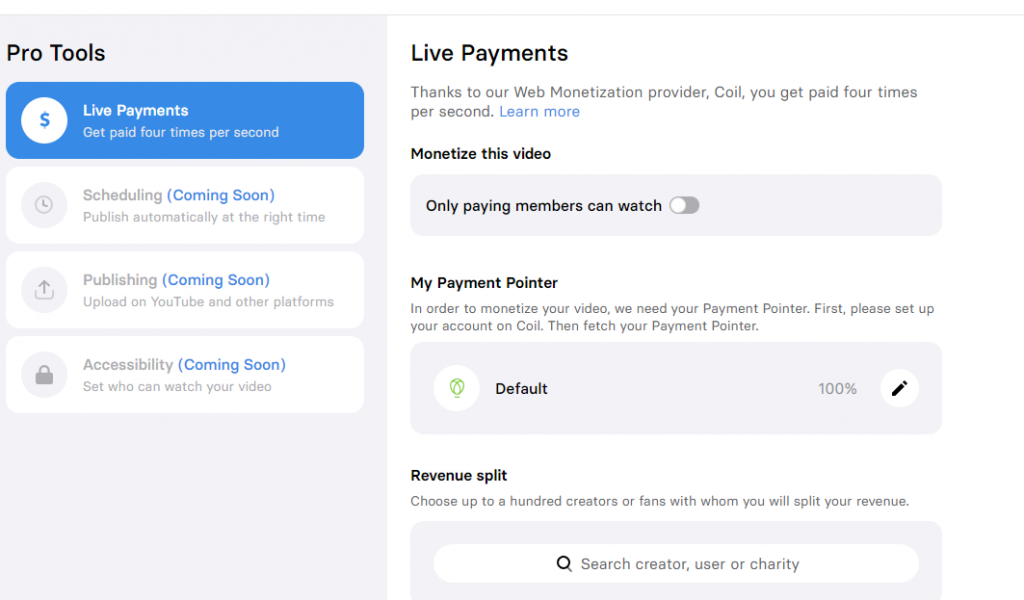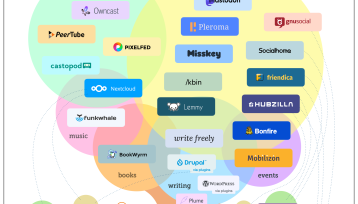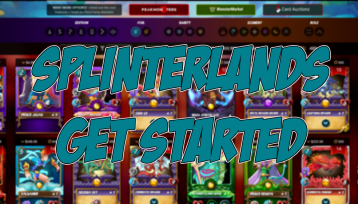Hi everyone!
I’m not sure if it’s been super clear… but I am really excited about all the potential in blockchain technologies. Efficient settlement of payments, smart contracts, DAOs, governance, there’s so much to be excited about.
One technology I’m really excited about is called Web Monetization.
Simply put, Web Monetization is the process where people get paid for the time that their audience spends on their content.
It sounds fair right?
If you create something terrible… then people won’t spend much time on it, and you don’t get paid well. If you create something that’s short and sweet and appeals to a large amount of people, you do get paid well… or if you create something that’s long and interesting but only appeals to a small amount of enthusiastic people then you get paid well.
There are a ton of benefits to this kind of system, here’s the TLDR;
- Creators could concentrate on just creating the beloved content
- Creators wouldn’t need to rely on ads, sponsors, etc
- Creators wouldn’t need to spread themselves all over the internet
- Creators don’t need to spend time on courses, merch, brand deals to pay the bills
- Consumers can enjoy content without having their data stolen
- Consumers can pay a single amount to support all the content they enjoy
- Exclusive content can be provided to subscribers
- Payments can be shared amongst contributors
- Brand new creators can get paid on their very first post
- Clickbait for stats to appeal to advertisers is unnecessary
- No need for creators to need to drum up millions of followers
- Traditional social media platforms can’t be the gate keepers
Creators could concentrate on just creating the beloved content
I remember when I was first interested in blogging, I read on a popular blog that they estimated only 5-10% of their time was actually creating content. The rest of their time was connecting with other businesses and their audience in order to build their business.
They saw their content as just the way to lure in potential customers. Converting their audience to customers was a big time sink, as well as constantly developing products to sell and organizing brand deals to sell other companies products.
When I read all this… it was enough for me to shut down my computer and give away the whole blogging thing. I wasn’t excited about any of that… I just wanted to create the things that I wanted to create and not worry about anything else. Web Monetization could potentially allow me to do that.
Creators wouldn’t need to rely on ads, sponsors, etc
Spent much time on YouTube and you’ll likely hear a creator talk about being demonetized. I can understand that it’s a massive source of confusion and frustration… and I can also understand that YouTube makes its literal billions with advertising. Advertisers definitely do not want to be associated inappropriate content… so most creators are trying to toe the line of being advertiser-friendly, but still more interesting than, say, content found on cable.
YouTube became popular originally because it wasn’t advertiser friendly. People flocked to the platform because it was so much more interesting than anything seen on television…. this obviously changed when advertisers started leave en masse after their ads were being shown on unsavory videos.
A lot of my favourite YouTube channels have interruptive ads (which I never see, thanks Brave Browser, but I’m devastated whenever I don’t watch with Brave because there are just so many ads) and then they also have to talk about their Sponsors which rarely have anything to do with their content. It’s all so annoying. It’s the same with podcasts as well. I understand why they have to do it, but I’d really rather not listen to them all talk about the exact same sponsor all the time. It’s so boring.
I have no idea how much time and effort creators have to put into obtaining sponsors, making sure they’re happy with the content, invoicing, chasing payments, etc etc… I imagine it’s not fun.
The only creator whose sponsored ads I might possibly endure is Cody, and that’s because they are as weird as could be while somehow kind of staying on script, a little…. but I’m sure Cody would prefer to, y’know, not.
Creators wouldn’t need to spread themselves all over the internet
Obviously creators who are starting out may need to drum up some followers, but generally with traditional social media we’re seeing a lot of creators managing their accounts on all the big social media platforms to increase their reach, and in case they get deplatformed, banned or demonetized on their main platform.
For, say, a Twitch creator… they’d stream on Twitch, and then create compilations for YouTube and then create snippets for Instagram, Snapchat and TikTok while potentially creating bonus content for Patreon, and probably managing a Discord server or Telegram channel.
It’s a lot.
For most creators the people who follow them, follow them on all of the platforms… which means a ton of repetition, but its necessary when so many creators get into trouble with their main platforms. Lots of creators get into trouble and often have no idea exactly which bit of their content caused them problems, which again can be frustrating and confusing.
Maintaining engagement on all of those platforms is a huge time sink. It’s no wonder the bigger creators have teams to help them. Obviously this is only an option for the top creators.
With a Web Monetization system in place, creators might still need to do all that for their Web Monetized Twitch or YouTube channels, but if they mainly have their own website that hosts their content, then they can’t be deplatformed. They’re not at the mercy of any platform and can just attract their audience to their main site.
Creators don’t need to spend time on courses, merch, brand deals to pay the bills
Some of the influencers I know on Instagram are pretty much hounded hourly by brands to create posts for their products, and they tell me that it’s a massive hassle. The large percentage of brands that instigate these conversations are for products that the creator has no interest in and does not want to subject their audience to.
When, maybe eventually, an influencer is approached by a brand whose product or service is something that they would be happy to display/talk about, that starts a whole big discussion about what content must be in the post in order to achieve payment. Once that is all decided, the influencer makes the post, lets the brand know and the brand has to review. If the brand is happy, then an invoice is sent out and then, almost always, the influencer has to later chase up payments.
The hit rate of brands paying what they said they’d pay, when they said they’d pay it… is not high.
At this point, the influencers audience doesn’t love that they’re being advertised to and the influencer may lose some of the engagement and followers they worked so hard to acquire.
Other types of monetization, like creating courses or producing merch is a huge time sink that may or may not pay off in the future. Creating a course can take a really long time and the creator will never know if they’ll get paid for the time they put into the course, let alone if it will pay enough to allow the creator to spend more time creating content. Merchandise is often less intensive, but the costs may be greater and the margins lower.
It’s really hard for creators to get paid to create the content their audience loves… and this is where a system like Web Monetization makes it all much more simple and less complicated.
Consumers can enjoy content without having their data stolen
The saying ‘If you’re not paying for a product, you are the product‘ is very true on traditional social media. The movie The Social Dilemma showed me that way more data than I really could have ever expected is harvested and sold. Merely pausing on a post, not clicking any like or typing a comment or anything, is recorded. Everything is recorded. Facebook doesn’t actually even know where your data comes from or goes.
Consumers have their data sold onwards so advertisers can target them, and the data is so comprehensive that even though it is often anonymized (ie, the identifiable information is removed) it’s still extremely easy to identify you and link all your online habits. If someone in your house looks something up, you could be shown an ad about it. It’s extremely intrusive.
The thing is, it’s really easy for sites to totally respect their visitors privacy. With analytic sites like Fathom, sites can get all the analytic data they need (how many people viewed a page, what country their from, what device, etc) to make their site suitable for their audience without needing cookies or to have them tracked. Sites and platforms just choose not to because it’s an income stream for them.
Web Monetization doesn’t need any of that. It doesn’t care and privacy is a huge part of the protocol. With this system, sites don’t need advertisers, so then they don’t need cookies, or users data. It’s a win for (almost) everyone.
Consumers can pay a single amount to support all the content they enjoy
This is a huge advantage of Web Monetization!
Normally if you pay a subscription to a creator on Twitch, OnlyFans, FanHouse or Patreon, it’s a monthly cost that is just for the one creator.
If that creator doesn’t create, then that subscription is essentially wasted.
The subscriber may not know what to expect… is the creator just away for a day, a week, a month, a year? How long should the subscriber keep paying without getting the content they expect?
Instead, with Web Monetization, the amount paid for the subscription can be paid to any of the creators, websites or channels that use the Web Monetization protocol. Creators and sites are paid for the time spent on their content by the subscribers… so the subscribers should always be able to get a ton of value out of their subscription. If a number of creators just don’t have any content that month, there are plenty of other creators that will… or sites like Imgur or Hackernoon where the subscription provides ad-free service.
Exclusive content can be provided to subscribers
It’s an extra choice that creators can make.
I personally haven’t created much exclusive content at all, but I don’t have a huge audience either.
Creators who wish to provide exclusive content for those subscribers who are paying their bills can easily do so. They can make most, or all, or none or some of their content exclusive to those Web Monetization subscribers.
Creators don’t need to, because they still get paid when subscribers spend time on their content anyway, but they may choose to create exclusive content as a way of saying thanks… or to motivate more of their audience to take up a Web Monetization monthly subscription.
Payments can be shared amongst contributors
This functionality isn’t available everywhere, but the technology seems to support this. Hopefully new developments make this functionality available to everyone in the ecosystem because it’s such a great idea.
Cinnamon Video currently allows you to Revenue split up to a hundred different contributors:

This is incredible technology for collaborators.
You can add in the percentage that each collaborator would get, and payments get split while subscribers are watching those videos. This means that creators could add in a percentage of the revenue for music, editors, make up artists, producers, guests, models, researchers, etc etc.
At the moment, most video creators would need to pay contributors upfront (which isn’t terrible either) but it’s a gamble for everyone involved. If the creator’s video doesn’t do well, they’re at a loss after paying everyone up front, and if the creator’s video does extremely well, the contributors don’t see any extra revenue from that.
The revenue split opens up the potential for a much more fair (both in revenue and in risk) system that could open the doors to more successful collaborations.
This type of functionality is likely to need to be enabled at the application/platform level, but I do hope it becomes generally available. It’s such a huge advantage over so many other existing systems.
Brand new creators can get paid on their very first post
For many platforms like Twitch, YouTube, Instagram, Tik Tok, etc a creator needs to build up an audience and following before they might ever see their first payment. Of course, there’s always the chance that someone’s first video or post goes viral, but the odds of that happening are pretty low.
Sometimes building up enough of an audience to start making a cut of ad revenue takes years. One YouTube for example you need to pass 10,000 views before you are eligible to turn on monetization. On Tik Tok you need to be invited into the Creator Program and it’s not available in a lot of countries.
Making an income on an independent website might take considerably longer since most social media platforms make it harder to entice their users to click away. You might need to build up a very enthusiastic audience before you’re able to sell any products.
Conversely, with Web Monetization, depending on the platform, you could see payments come through on your first post or video. Obviously a subscriber would need to consume that content, but as soon as they do the creator is instantly paid for that time. It’s an incredible system.
Clickbait for stats to appeal to advertisers is unnecessary
Have you ever clicked on a link to an article or story just to find there is barely any more information that what was contained in the heading? Yeah? That’s just so that website can get lots and lots of views (even if it’s just for a really short time) so they can sell advertising space to brands.
The brands get a raw deal out of it, since you’re unlikely to stick around after feeling tricked by the site, and we all don’t love being tricked like that.
With Web Monetization, creators are paid for the time their audience spends with their content, and so the rewards just won’t be there for content that the audience clicks away from within seconds.
There is an overall benefit to society with this model.
If click-bait can be reduced, then misinformation and disinformation may also be reduced. Longer articles may make a website more money overall, so outrageous claims might need supporting evidence, which may make it easier for people to realise that the information doesn’t stand up to scrutiny.
Traditional social media platforms optimize their revenue with conflict. People tend to engage more when they’re enraged, and that’s made so much easier when people don’t have all the information on a subject. If Web Monetization can become a more dominant system for the internet, we all could benefit from deeper and more nuanced interactions.
No need for creators to need to drum up millions of followers
Making money on the internet is currently really hard.
Sure, you’ve got your Jenners making $1.5M per post but for normal people without massive platforms it’s extremely difficult, and often you need to build up absolutely massive audiences and interaction before you can make a livable wage. This can often take hours and hours to build up that engagement, or years.
There are platforms like OnlyFans, FanHouse and Patreon where a much smaller numbers of people can pay you a monthly subscription (OnlyFans also has tips) but because of the recurring payments it’s all about the promise of quality content. The audience is trusting the creator to start or continue creating content of similar or better quality, and when that isn’t provided, the audience feels frustrated and duped. On these platforms, creators need to create both free content to get people in the doors, and exclusive bonus content for the paid subscribers. It can be a lot to manage.
With a system like Web Monetization, the creator is getting paid literally while the audience is consuming that content. It doesn’t matter about the promise of future content or not, it’s all about this piece right now.
Technically, with Web Monetization you could create one incredible piece of content and earn money on it forever if people keep consuming it.
Traditional social media can’t be the gate keepers
There is a great Oatmeal cartoon that describes this situation really well:
Click here for the full cartoon, I’ll just include the main bits…




Which, of course, led to this…
The thing is… sites like Facebook, Instagram, Tik Tok, YouTube, Twitter, etc etc etc are nothing without all the user generated content. They would all be absolute wastelands without us. We have to endure the advertisements to see the content we care about, and now sites like Facebook will show me the content, not that I like the best, but is the best paid. These sites also want to keep users on their sites for as long as possible (even with all the societal damage that may cause) so they will not share posts as widely that contain links that would have people clicking away from their sites.
Obviously Web Monetization doesn’t immediately solve this issue. You may still need traditional social media as a means to get the word out about your content… but the difference is that creators may only need a small number of enthusiastic consumers visiting their site instead of trying to grab millions of followers on social media to make a lot less… especially when the platform actively works against you.
How does Web Monetization work?
Web Monetization was developed by the Interledger Protocol and has been embraced by the Web Monetization community.
The creator needs to set up a Payment Pointer (which is free) to direct the microtransactions/micropayments to.
The creator’s audience/subscribers need to set up a Browser Extension so that the protocol knows when they’re consuming content that has a Payment Pointer.
The audience also needs an active Coil subscription that costs $5USD per month. (Membership Overview)
Obviously no one loves paying for content they perceive as free… but the thing is, content isn’t free. Someone is paying for it, either by donating their time, or by letting it be interrupted with ads, corrupted by algorithms or selling your private data. There’s always a cost, and so Web Monetization makes it extremely clear who is actually paying (the subscriber) and who is getting paid (the creator).
Once a creator has a Payment Pointer set up and a subscriber has an active subscription and the browser extension set up… the creator will get paid for every second while the subscriber is consuming their content, instantly.
For instance, when a subscriber reads these very words, I’ll be receiving micropayments for it.

Personally I use Uphold.com for my micropayments. It was super easy to set up my Uphold Payment Pointer and then add that code to Coil.com, YouTube.com, gFam.live, Cinnamon.video, MG.Social, etc.
If you have any questions, let me know in the comments!
Please note : The above post may contain affiliate links.
Below are some product referral links that I love and will benefit us both if you’re interested.
Splinterlands – A super fun blockchain card game that I play almost every day.
Fathom Analytics – Cookie notices no longer needed since Fathom doesn’t track data. You can see this site’s analytics right here.
Coil – A $5 USD monthly subscription fee provides you access to a ton of content and sites in a way that fairly rewards the creators of that content.
Exxp – The WordPress App to link your blog to the Hive blockchain.
NomadTask – Earn for completing online tasks like following accounts or completing reviews.
MINT Club – Create your own Smart Media Tokens with no coding required.
GALA Games – Gala is creating a whole platform of blockchain games. Definitely excited about Mirandus, Townstar and SpiderTanks.
MCO – Use my referral link https://crypto.com/app/9h9jnlxun9 to sign up for Crypto.com and we both get $25 USD.
Aptera – Get 30% off the reserve price for this incredible electric vehicle. (My post)


